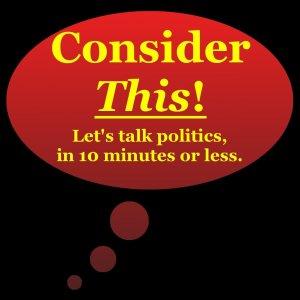Consider This! | Conservative political commentary in 10 minutes or less

Episode 168: Neil Gorsuch, and the Red-Tape Reduction Act
President Trump has made his choice for Supreme Court, and I think it’s a fantastic one. Neil Gorsuch is an Originalist, meaning he believes the Constitution says what it means, and not what 9 Justices think it means this week. If the government can redefine the law on a whim, how are we, the people, supposed to know what the law really is?
And conservatives have talked about cutting red tape and getting rid of useless regulations for a long time. It looks like that idea’s time has come. In fact, it’s been tried on a smaller scale and it’s worked incredibly well. Listen in for who did it, how it’s helped, and how it’s getting done here.
Mentioned links:
The Red Tape Reduction Act
Doug Black [Wikipedia]
Cutting Red Tape in Canada: A Regulatory Reform Model for the United States?
Canada Cuts Down On Red Tape. Could It Work In The U.S.?
Trump signs executive order requiring that for every one new regulation, two must be revoked
Trump Nominates Neil Gorsuch to the Supreme Court
Partisan Standoff Leaves Supreme Court Seat Empty for More Than 350 Days
Show transcript
Have you heard of the Red Tape Reduction Act? It’s a great idea that has been introduced to try to reduce, or hold the line, on the number of government regulations that are out there that slow down the economy, make it hard to open a new business, and generally live our lives.
Senator Doug Black describes it this way.
Businesses spend valuable time and resources wading through unnecessary red tape. By reducing this red tape, we will inevitably increase innovation, productivity, job creation, and international investments. We all benefit when the country is able to maintain a competitive edge in business.
[The] One-for-One rule will ensure that for every regulation imposed on a business, one will be removed. It also ensures that the federal departments and agencies enforcing the regulations will offset any administrative burden a business faces due to these regulations. Among the bill’s aims are improving regulatory design and governance and improving the service offered to businesses by the government.
This was actually tried on a state level first, and it worked incredibly well, starting with a 2-for-1 swap that reduced regulations, and scaling back to 1-for-1 later. Overall, regulations have been reduced 40%. That state has gone from being one of the economically worst-performing in the country to being among the best. Economic growth increased from 1.9 percent below the national average between 1994 and 2001 to 1.1 percent above the average between 2002 and 2006. GDP grew faster there than in the nation at large every year between 2002 and 2008, and thousands of new businesses were created during this period.
It’s a fantastic, conservative idea whose time may now have come; get government out of all the meddling it does. Forest companies were told what size nails they had to use the build a bridge. Restaurants were told what size televisions they could have in their establishments. Kids even were affected. They were being told they needed 2 permits to show a tadpole in their classroom at show and tell.
OK,






 Visit Podcast Website
Visit Podcast Website RSS Podcast Feed
RSS Podcast Feed Subscribe
Subscribe
 Add to MyCast
Add to MyCast